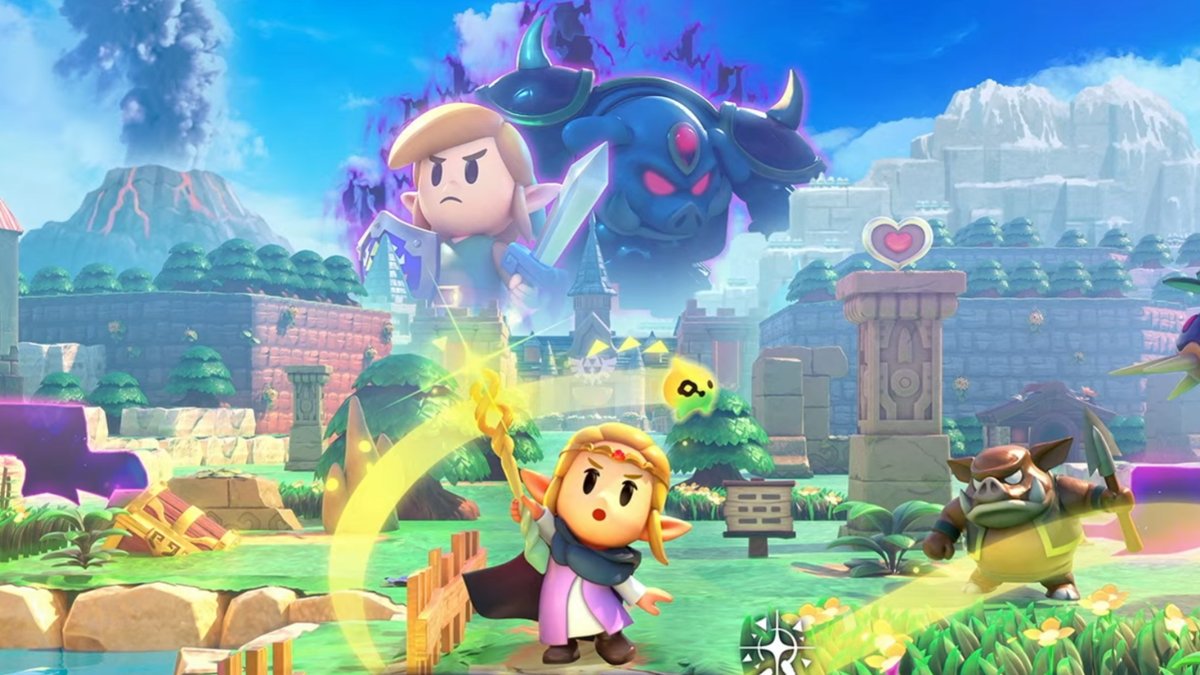
The Legend of Zelda: Echoes of Wisdom
MSRP $60.00
“The Legend of Zelda: Echoes of Wisdom only feels like the beginning for what could become a great Zelda saga.”
Pros
- Echoes make for clever puzzles
- Great exploration
- Classic formula still holds up
- Excellent music
Cons
- Limited selection of echoes
- Poor echo UI
- Some out of place systems
When I think back on my decades’ worth of Zelda memories, there’s one that sticks with me the most: that time I squashed Dark Link like a bug.
Partway through The Legend of Zelda: Ocarina of Time, Link must fight his doppelganger. The shadowy villain is his perfect match, countering every one of his sword slashes. It’s a tough fight — or at least I imagine it would have been. Rather than trying to beat him the old-fashioned way, I simply equipped my Megaton Hammer and squashed him like a bug. Anytime I’ve relayed that story to a friend, they’re almost always surprised. They’d either out-slashed him or fought back with their bow. It’s a simple moment, but one that makes my playthrough feel special. It’s not just Link’s adventure that I’m tuning into; it’s my own, too.
Nintendo has drilled down on that feeling with recent games like The Legend of Zelda: Tears of the Kingdom, but now it’s taking that idea to its classic formula. The Legend of Zelda: Echoes of Wisdom both revisits and reinvents the series’ top-down days by placing Princess Zelda in the lead role and giving her a new item-copying ability. That change opens the door for a whole adventure full of “Dark Link” moments, as every challenge in Hyrule becomes an open-ended puzzle. It’s a great idea for a series that thrives on change, but one that’s not yet fully realized. With a limited selection of objects to copy and a safe reliance on series staples, Zelda’s first solo adventure doesn’t fully step out of Link’s shadow.
Playing with echoes
The Legend of Zelda: Echoes of Wisdom flips the usual Zelda story on its head when mysterious rifts open up around Hyrule. Link gets trapped in one and disappears, so Zelda must step in to save the day. She gets a little help from a round critter named Tri who gives her the Tri Rod, a staff that can copy objects and enemies as “echoes.” It’s a clever gameplay twist that homes in on a different piece of the Triforce for a change. While Link’s games are all about showcasing courage, Zelda’s story is all about testing players’ wisdom.
Echoes of Wisdom thrives on creative flexibility.
The foundation of Echoes of Wisdom is refreshingly familiar coming off the last decade of reimagined Zelda games. It’s a top-down adventure filled with traditional dungeons, small keys, collectible heart pieces, and more pre-Breath of the Wild staples. That’s all made new thanks to echoes. The system’s strength is that it’s so easy to grasp right from the jump. If an object has a shine around it, I can press my right trigger to copy it. From then on, I can summon it anytime I want with no restrictions. The only thing keeping me in check is the fact that each echo has a specific summon cost and I have a limit as to how many ticks of echo energy I can expend at once. With virtually no friction, I can experiment to my heart’s content, turning every stretch of Hyrule into a little sandbox.
Rather than slashing away problems, Echoes of Wisdom thrives on creative flexibility. What’s the best way to get past a patrolling guard without getting seen? One player could hide in a pot to evade their eyes, while another may opt to construct a bridge out of beds and run above them undetected. That idea flows into every piece of the Zelda formula, from platforming to dungeon puzzles to boss fights. No two playthroughs will look the same.
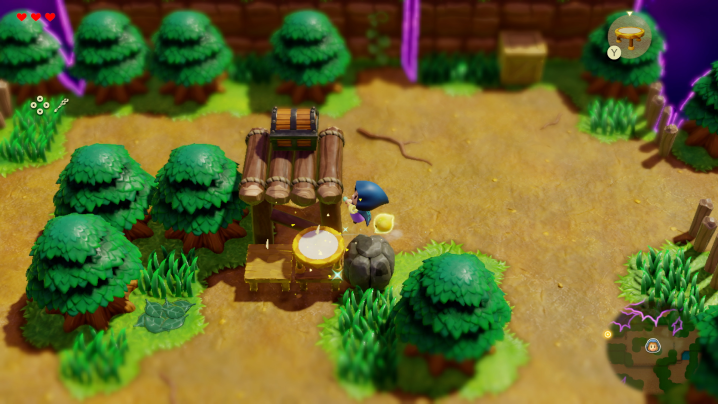
In its best moments, that idea is a perfect formula fit that calls all of my favorite Zelda memories to mind. My treasured Dark Link fight comes back to me in an early battle against a rift-infected Link when I summon a keese to distract him so I can safely scheme from behind. When I find myself building a tower of trampolines and boxes to scale a high cliff, I think back to the time I bypassed a Tears of the Kingdom shrine by building a comically impractical bridge over a water current. Breath of the Wild was the start of a new era, but Echoes of Wisdom cements that game’s approach to player agency as the central vision for the series moving forward.
While echoes are a great idea, the system isn’t fully realized here. I’m surprisingly limited in what I can actually copy, with no in-universe explanation as to why. One sidequest tasks me with finding a treasure chest for a Zora. I figured I could copy one and summon it, but it turned out that it was an item I couldn’t copy. In fact, of the over 100 echoes available in the game, very few of them are for items with unique effects. The bulk of what I end up copying are interchangeable monsters who I can summon to fight for me as I stare on passively. Battles feel a bit like a small-scale strategy game, but with much less tactical decision-making. Once I capture the most powerful moblin on the block, there’s no need for me to summon any of the other dozens of creatures that are just stand-ins for computer-controlled swords.
That’s a running problem in Echoes of Wisdom, as it often steps on its own design with a small handful of useful echoes that trivialize its handcrafted elements. There’s no need to build a clever contraption to scale vertical heights when a wall-climbing spider gets the job done every time. There may be tons of echoes to copy, but only a few feel like they matter. Easy shortcuts like that came around to bite me late in the game when I discovered a minigame that asked me to “glide” through wind currents. I had no idea how to do it and wondered if I’d just missed an item somewhere in my adventure. I hadn’t; I had just completely steamrolled through a dungeon that was meant to subtly teach me how to do that by using basic beds and boxes to cross puzzle rooms.
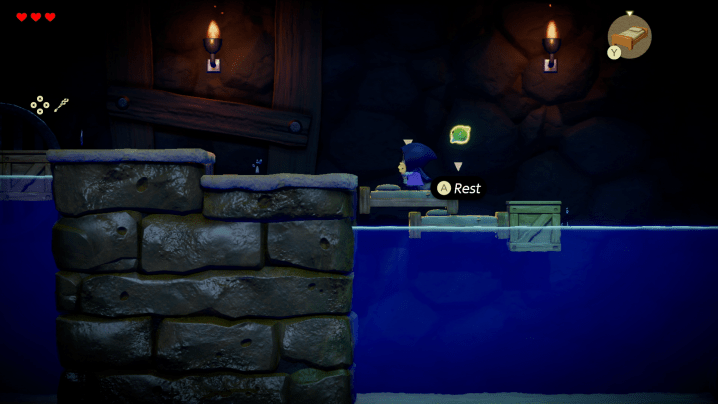
I’m incentivized to overly rely on items like that due to poor UI. Whenever I want to call an echo, I have to scroll through a horizontal menu (straight from Tears of the Kingdom’s playbook) with every single option. You can imagine how cumbersome it becomes to scroll through it once you have a few dozen options. There are filters to help organize them, but “Most Used” becomes the easiest way to call a handful of go-to options quickly. That meant I was eventually stuck in a loop using the same quickly accessible echoes. Otherwise, I’d have to spend time scrolling through a long, single-line menu to find what I’m looking for. It’s a total momentum killer, so sticking to some key echoes is a more appealing option.
Even with those frustrations, I see a future in this style of play. The “eureka!” moments are powerful and they don’t require an engineering degree to arrive at them. Echoes of Wisdom better democratizes the core ideas of Tears of the Kingdom, making it easy for a kid or casual player to feel like they’ve sequence broken the adventure with some clever summoning. It’s a great starting point, but I imagine we won’t see the full power of it until developer Grezzo gets a second crack at it.
The smoothie problem
Echoes aren’t the only way that the adventure brings Breath of the Wild’s design pillars to the classic Zelda formula. Its DNA can be felt in Echoes of Wisdom’s open-ended exploration, long list of sidequests, perk-granting accessories, and more. In many cases, those ideas are a natural fit. Echoes of Wisdom is the largest top-down Zelda to date and it gives players more ways than ever to explore Hyrule. Anytime I obtained a useful new echo or accessory, I’d find myself running around the map all over again to see how that tool could help me find something I’d missed.
While Breath of the Wild looked like a radical departure from the Zelda series in 2017, it’s still probably the closest a game has come to matching the feel of the very first entry. The NES classic felt like the first true open-world game with its sprawling map full of secrets. Subsequent Zelda games would chip away at that more and more over the decades, but Echoes of Wisdom brings back that feeling. Exploration is satisfying here, sometimes leading me to secret bosses or surprise mini-dungeons that I might not find until my sixth pass through an area.
The great moments of discovery deflate the moment you uncover a mundane stack of common resources.
Not every idea from the Breath of the Wild formula is a neat fit, though. Rather running through every single misstep, let’s break down one single mismatch that sounds like an arbitrary complaint on paper: smoothies.
Like its recent counterparts, Echoes of Wisdom features a cooking system. Zelda can craft smoothies by simply combining two ingredients. The concoctions will heal her, but also occasionally grant her perks like chill resistance or increased climbing speed. Like a lot of strengths here, it’s a streamlined process that even a kid could pick up with little friction. It’s Grezzo trying to take a key staple of Breath of the Wild and fit it into a smaller package.
It may sound minor at first, but it becomes another area where Echoes of Wisdom trivializes itself by smashing too many ideas together. The echo system means that dangerous situations like combat are fairly passive. There aren’t a lot of situations where Zelda is at risk of losing her health and in need of a smoothie to fix it. When she is hurt, she can simply summon a bed at any time and lay down for a few seconds to recover. Perks like increased climbing speed or faster diving never really make sense either, as the world here isn’t terribly vertical.
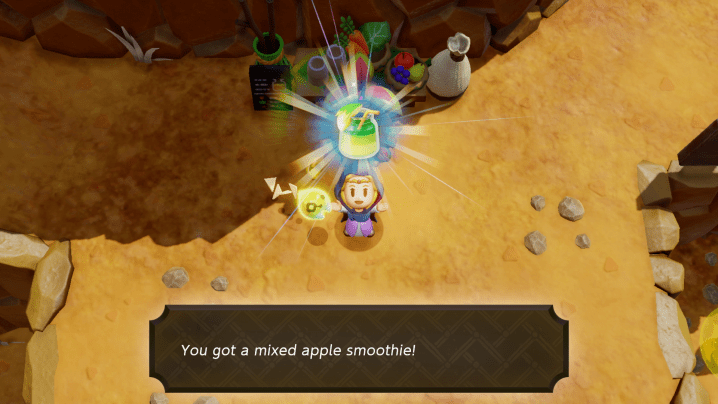
I rarely need to drink a smoothie, so my limited inventory spots are always filled with them. That means I can’t make more, in turn leaving me with a glut of ingredients. That’s a problem, because I’m constantly finding the same few smoothie ingredients everywhere I go. They aren’t just random pickups, but often nestled in chests as well. If you find a well-hidden secret or crack a brainy puzzle, you’ll probably find a chest full of apples waiting for you instead of a heart piece (or you’ll find rupees, but take one guess about what you’ll mostly buy with those). The great moments of discovery deflate the moment you uncover a mundane stack of common resources you have little need for.
This is just a small example of how one unassuming design decision so often snowballs in Echoes of Wisdom. There’s a good reason why top-down Zelda games weren’t flush with the same systems as an open-world game. Breath of the Wild is a survival game. It calls for crafting hooks to support that. Echoes of Wisdom is, at its core, a large-scale puzzle game. Anytime something butt heads with that vision, I can feel Grezzo reaching a little too far past that scope to try and turn something elegant into a grand adventure worthy of the Zelda name.
Keeping it old school
While Echoes of Wisdom struggles to nail down its voice, there’s still something comforting about returning to the more traditional Zelda setup. It’s great to explore full dungeons again, even if there are a few duds in the bunch. I still love the simple joy of finding a heart piece and seeing my health bar slowly expand. There is something so primally enjoyable about the formula, and Grezzo uses its learnings from remaking Link’s Awakening to bring that satisfaction back to the surface.
The developer has found a great aesthetic match for it too. The toy-like chibi visuals are sure to be divisive, but they give the world a bright and playful look that fits its new ideas. Echoes are ultimately toys that I can smash together, so it’s fitting that they almost look like shiny plastic Amiibos; I just want to play with them. The soundtrack also sports some fantastic orchestrated tunes that call back the series’ best tunes. There’s an infectious, whimsical energy to it that we haven’t heard since 2013’s A Link Between Worlds.
Echoes of Wisdom’s best parts are the ones that break away from what’s expected.
There’s a downside to that, though; Echoes of Wisdom is perhaps a little too invested in nailing that nostalgia. Despite being filled with so many new systems, it’s surprisingly light on creativity. The story takes me through the same locations I’ve come to expect from the series. I chop it up with Gorons in the mountains and swim with the Zora. Old characters like Impa return like clockwork, but I meet few new ones outside of Tri. Dungeons are hidden in the Still World, a much smaller iteration of A Link to the Past’s Dark World premise that’s appeared in so many Zelda games since. Even the story is a bit phoned in compared to previous games, with Zelda simply hunting down a big bad, closing rifts, and saving Tri’s friends.
Then there’s Zelda herself, who finally gets the starring role she’s long deserved. While it’s great to control her for a change, sticking so close to the script means that she’s not much of a character. She’s a voiceless hero like Link who only communicates through limited pantomiming. Nintendo doesn’t seem entirely confident about letting her have her own identity, either; early on, players unlock Swordfighter Form, which briefly imbues her with Link’s basic powers. It’s a fail-safe that’s sure to appease skeptical players who aren’t keen on the puzzle emphasis, but it’s a move that makes Zelda feel like an alternate costume.
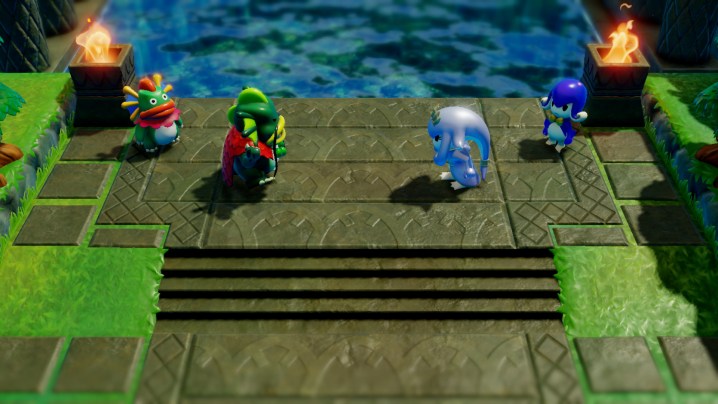
Echoes of Wisdom’s best parts are the ones that break away from what’s expected. My favorite moments largely happen in Still World rifts, where I need to carve my own path through twisted snippets of Hyrule’s world using echoes. I’m attuned with Zelda most when I find a large gap I can’t pass, but realize I can get to the other side by grabbing hold of a flying tile with my bind ability and following its path. In clever puzzle platform moments like that, I feel like I’m tapping into her third of the Triforce; I’m using her wisdom to meet any challenge that arises. And I’m doing that by drawing on her connection to all things within her kingdom and communicating her eternal royalty through tangible play.
This only feels like the true first chapter of Zelda’s saga, but I expect we’ll really see her grow into her element in her next adventure. Legends aren’t built in one game.
The Legend of Zelda: Echoes of Wisdom was tested on Nintendo Switch OLED.











